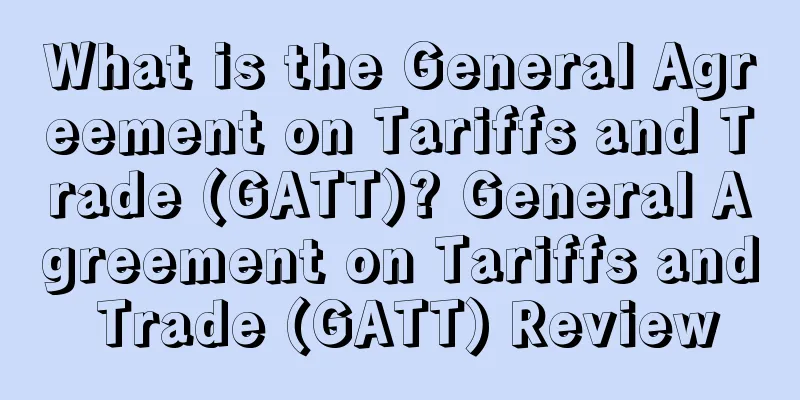What is the General Agreement on Tariffs and Trade (GATT)? General Agreement on Tariffs and Trade (GATT) Review

|
The General Agreement on Tariffs and Trade (GATT) is an international agreement concluded in the Bretton Woods system to regulate and promote international trade and development. Signed on October 30, 1947, entered into force on January 1, 1995 The global economic depression in the 1930s is considered one of the important causes of World War II. The "trade protectionism" that led to the Great Depression was also reflected upon after the war, making it possible to achieve smoother international trade and improve the open policies of various countries. Under the framework of the Bretton Woods Agreement in 1944, with the assistance of the International Monetary Fund and the International Bank for Reconstruction and Development, many countries signed the General Agreement on Tariffs and Trade in October 1947, which officially came into effect the following year (1948). The principles of the General Agreement on Tariffs and Trade are freedom (Article 11: conversion of trade restrictive measures into tariffs, and reduction of tariff rates), non-discrimination (most-favored-nation treatment, national treatment) and diversity. Free trade must be conducted under these three principles. Background of the Agreement In the 1930s and 1940s, world trade protectionism prevailed. Mutual restrictions on international trade were an important cause of the world economic depression. After the end of World War II, solving complex international economic problems, especially formulating international trade policies, became an important task facing all countries after the war. In February 1946, the first meeting of the United Nations Economic and Social Council was held, which called for the convening of a United Nations Conference on Trade and Employment to draft the Charter of the International Trade Organization and conduct negotiations on global tariff reductions. Subsequently, the Economic and Social Council established a preparatory committee. In October 1946, the Preparatory Committee held its first meeting to review the draft charter of the International Trade Organization submitted by the United States. The participating countries of the Preparatory Committee agreed to negotiate on issues such as reducing tariffs and other trade restrictions and drafting the "Charter of the International Trade Organization" before the establishment of the "International Trade Organization". From April to July 1947, the Preparatory Committee held its second plenary session in Geneva to negotiate on tariff issues and discuss and revise the draft "Charter of the International Trade Organization". After many rounds of negotiations, the United States and 23 other countries signed the "General Agreement on Tariffs and Trade" in Geneva on October 30, 1947. According to the original plan, the GATT was only a transitional step before the establishment of the World Trade Organization, and most of its provisions would be incorporated into the "World Trade Organization Charter" after it was adopted by all countries. However, given the differences among countries in their foreign economic policies and the legal difficulties that most governments face in approving a treaty as broad-ranging, highly organizational and international as the "International Trade Organization Charter", the Charter is unlikely to be passed in the short term. Therefore, the 23 founding countries of the GATT signed the Interim Protocol at the end of 1947, promising to follow the provisions of the GATT in future international trade. The Protocol came into force on January 1, 1948. Since then, the validity period of the GATT has been repeatedly extended and revised several times to adapt to the changing situation. As a result, the GATT has become a trade standard that all countries abide by and the only multilateral international agreement that coordinates international trade and national economic policies. Purpose of the Agreement The preamble of the General Agreement on Tariffs and Trade clearly states its purpose: The Contracting Governments consider that in the conduct of their trade and economic affairs their relations should be directed towards raising standards of living, securing full employment, securing a substantial and sustained increase in real income and effective demand, extending the full utilization of the world's resources and developing the production and exchange of commodities. Contribute to this end by reaching mutually beneficial agreements, substantially reducing tariffs and other trade barriers, and eliminating discriminatory treatment in international trade. History The first version of the General Agreement on Tariffs and Trade was signed in 1948 by 23 countries: Australia, Belgium, Brazil, Burma, Canada, Ceylon, Chile, the Republic of China, Cuba, Czechoslovakia, France, India, Lebanon, Luxembourg, New Zealand, Norway, Pakistan, the Netherlands, Syria, Southern Rhodesia, South Africa, the United Kingdom and the United States. The General Agreement on Tariffs and Trade (GATT) was updated in 1994 (GATT 1994), which included new treaties between the signatories. Most notably, the World Trade Organization was established. On January 1, 1995, 75 GATT signatories and the European Community became the founding members of the WTO. The other 52 GATT members joined the WTO in the following two years (the last being Congo in 1997). Since the establishment of the WTO, 21 non-GATT countries have joined the WTO, and 28 countries are currently in the negotiation stage. Of the original GATT members, only Yugoslavia has not joined the WTO. Target
Contents of the Agreement The General Agreement on Tariffs and Trade consists of a preamble and four parts, totaling 38 articles, with several annexes. Part I, from Articles 1 to 2, stipulates that the contracting parties shall provide each other with unconditional most-favored-nation treatment and tariff concessions in tariffs and trade. Part II, from Articles 3 to 23, stipulates the elimination of quantitative restrictions and the exceptions and emergency measures allowed. Part III, from Articles 24 to 35, stipulates the procedures for acceptance, entry into force, suspension or withdrawal of concessions and withdrawal from this Agreement. Part IV, from Articles 36 to 38, stipulates trade and development issues of developing countries among the contracting parties. This part was added later and came into effect in 1966. The purpose of the Agreement is to improve the living standards of the people of the contracting parties, ensure full employment, growth in real income and effective demand, and expand the utilization of world resources. The main contents are: ① The most-favored-nation treatment applies. The unconditional most-favored-nation treatment principle shall apply to the import and export of goods and related tariff and fee collection methods, regulations, sales and transportation between the contracting parties. However, customs unions, free trade zones and preferential arrangements for developing countries are exceptions to the most-favored-nation treatment. ② Tariff concessions. The contracting parties reduce each other’s tariffs on a reciprocal basis through negotiations and impose constraints on the results of the concessions to ensure that the export goods of the contracting parties are subject to stable tariff rates. ③ Eliminate import quantity restrictions. The General Agreement stipulates that import quantity restrictions should be abolished in principle. However, there are exceptions due to difficulties in the balance of payments. ④ Protection and emergency measures. If an unexpected situation or a sharp increase in the import volume of a certain product causes serious damage or a serious threat to the producers of the same product or those directly competing with it, the contracting party may suspend the obligations it has undertaken, or withdraw or modify the concessions it has made, to the extent and for the time necessary to prevent or correct such damage. Differences with the World Trade Organization
Trade negotiations GATT countries sometimes coordinate new trade rules that apply to all countries. Each round is called a "round". Usually each round involves reducing tariffs, but it also often includes many special treatments for individual products.
limitation Since the General Agreement on Tariffs and Trade is not a formal international organization, it has many limitations in terms of system and rules.
It is precisely because of the above-mentioned limitations of the General Agreement on Tariffs and Trade that this temporary quasi-international trade organization was eventually replaced by the WTO. |
<<: What is the Kirin Plan? Kirin Plan Review
>>: What is Yaodou.com? Yaodou.com Review
Recommend
What is Shenzhen Texun Cross-border E-commerce Co., Ltd.? Shenzhen Texun Cross-border E-commerce Co., Ltd. Review
Shenzhen Texun Cross-border E-commerce Co., Ltd. i...
What is Amazon online arbitrage? Amazon online arbitrage review
Amazon online arbitrage is the online version of r...
US online shopping trends: 94% change their shopping decisions due to logistics and delivery methods
Recently, DHL released the "U.S. Online Shopp...
What is Wish Express? Wish Express Review
Wish Express (abbreviated as WE) is Wish's ove...
Jurassic World also ordered a weird thing in Amazon?
As the originator of e-commerce Amazon's produ...
Summarize the current situation, methods and cases of using CPC advertising to promote products on Amazon platform
Analysis of advanced techniques for Amazon CPC adv...
What should I pay attention to when buying an Amazon account?
Quickly promote the 14th article outside the site ...
Sales exceed one trillion US dollars, and the 2023 North American e-commerce market insight report is released!
For a long time, we have been committed to explori...
20 common problems that new Amazon users often encounter when registering an account
Some common sense questions that novice sellers o...
What is Xiamen Hexin? Xiamen Hexin Review
Xiamen Hexin E-commerce Co., Ltd. (formerly known ...
Amazon operation tips: How to quickly become the best seller on Amazon?
The Amazon best seller logo is an orange icon tha...
What is SellerGrowth? SellerGrowth Review
SellerGrowth is committed to solving tax risks and...
Got bankrupt overnight? A Shenzhen cross-border company ran away due to unpaid rent, and the FBA fees of the European site increased again!
▶ Video account attention cross-border navigation ...
What is JOOR? JOOR Review
Founded in 2010, JOOR is a B2B e-commerce platform...
What is Dolphin Japan Warehouse? Dolphin Japan Warehouse Review
Dolphin Japan Warehousing Center is a product of S...









